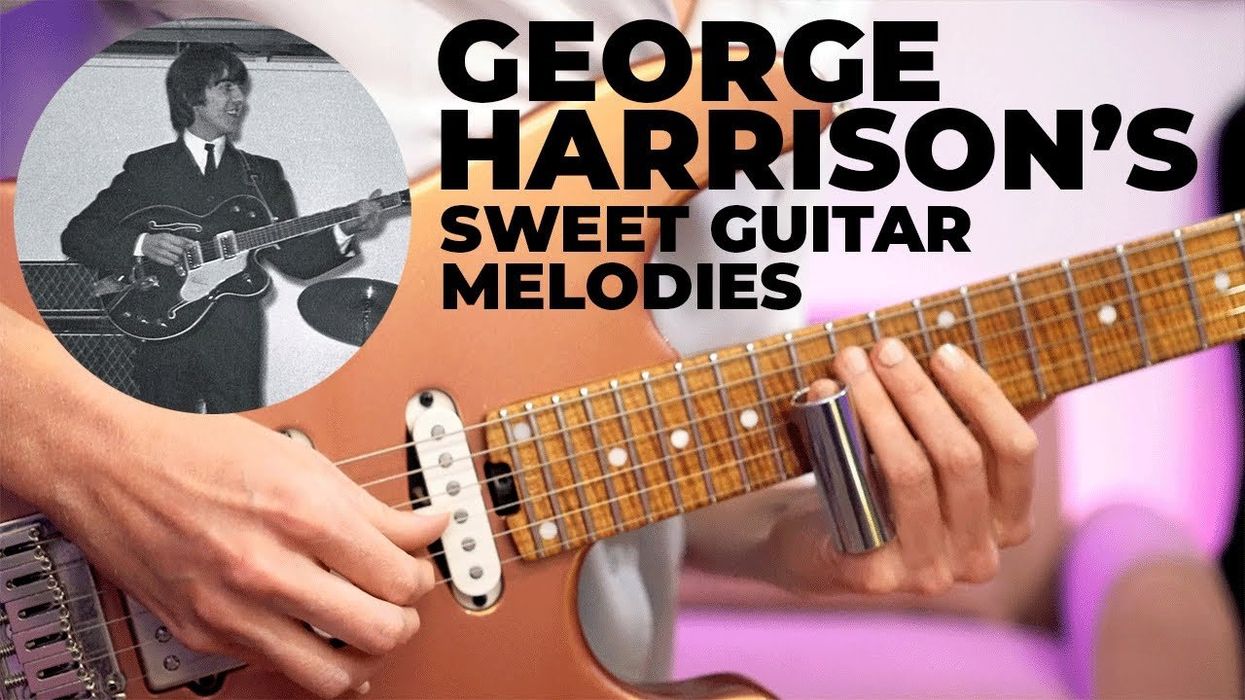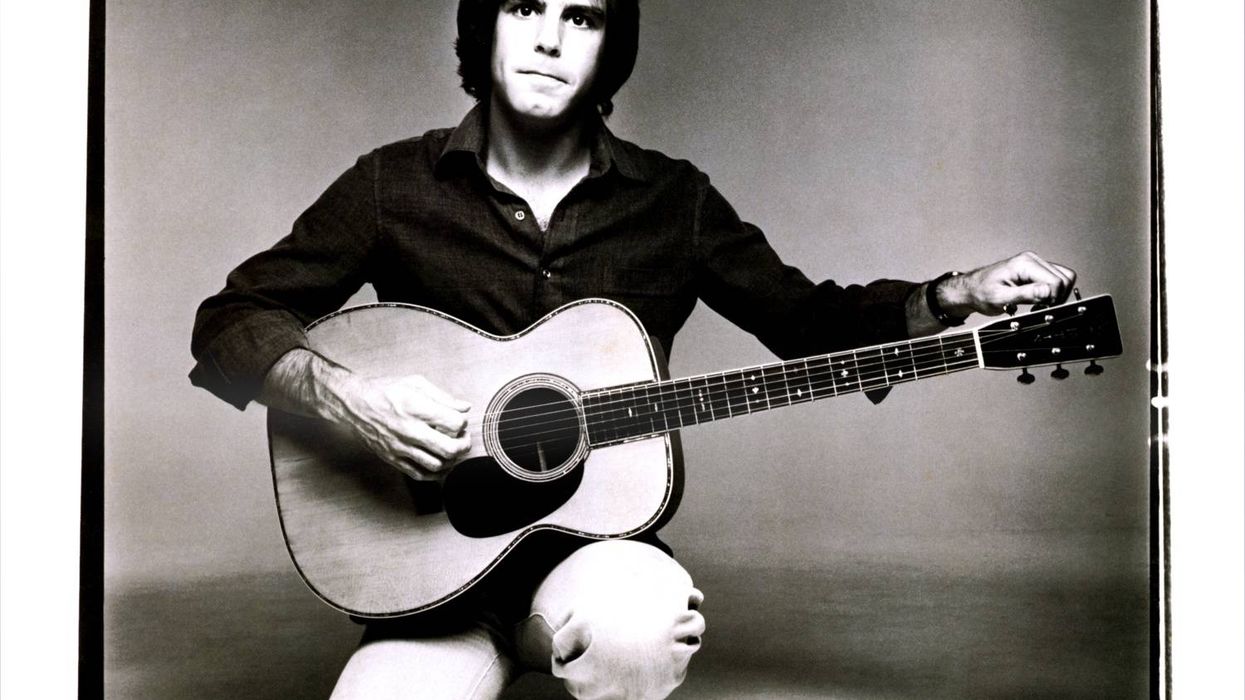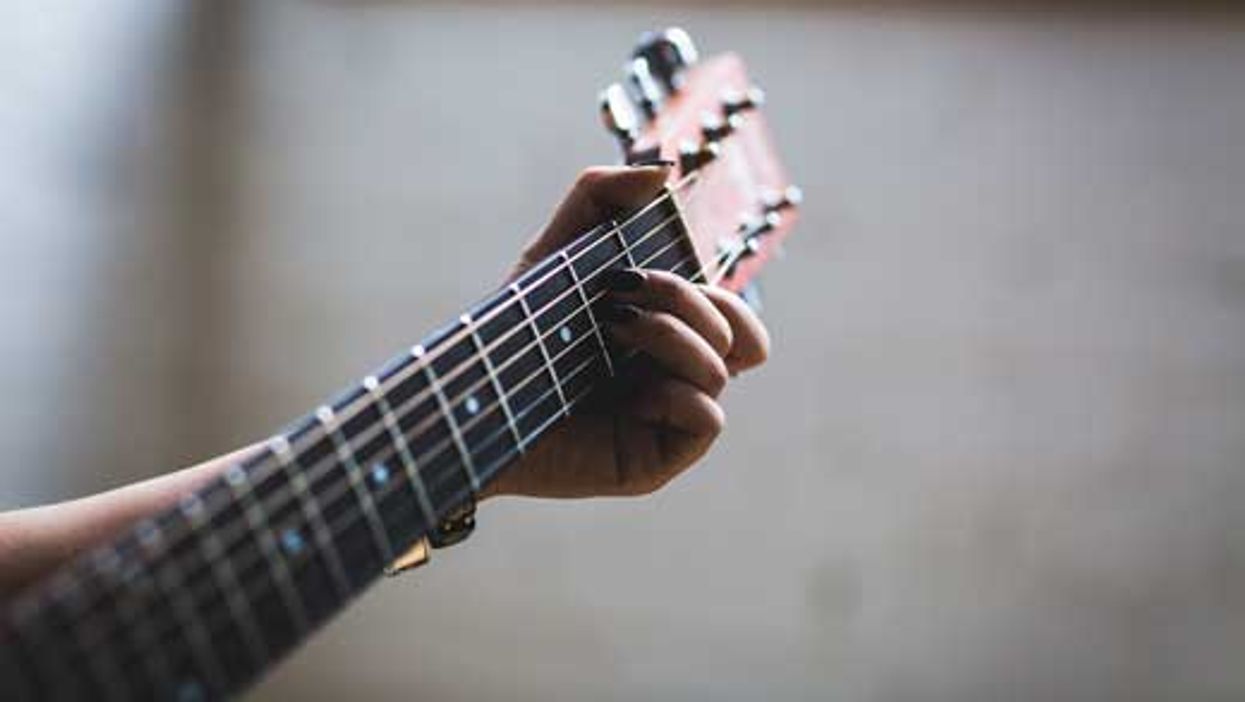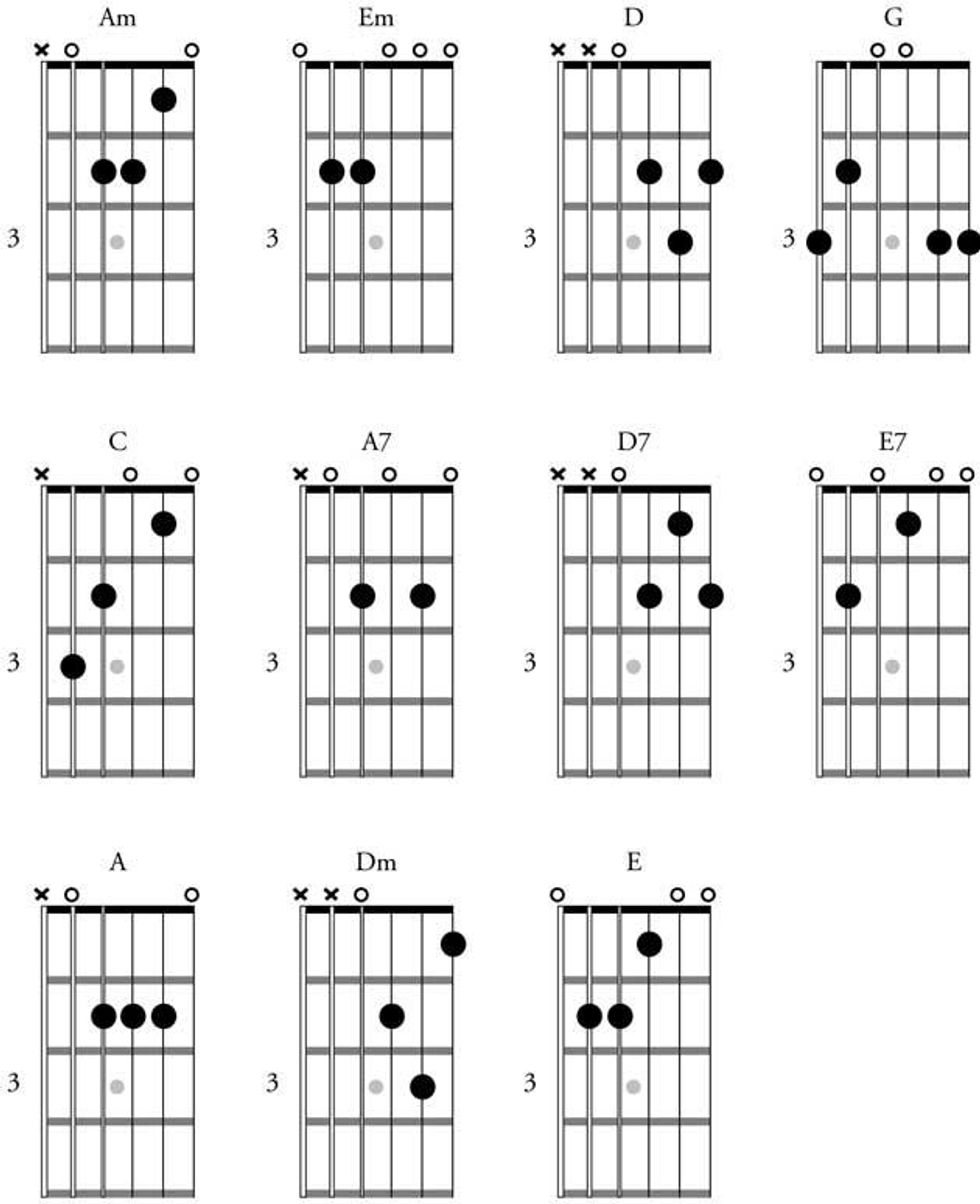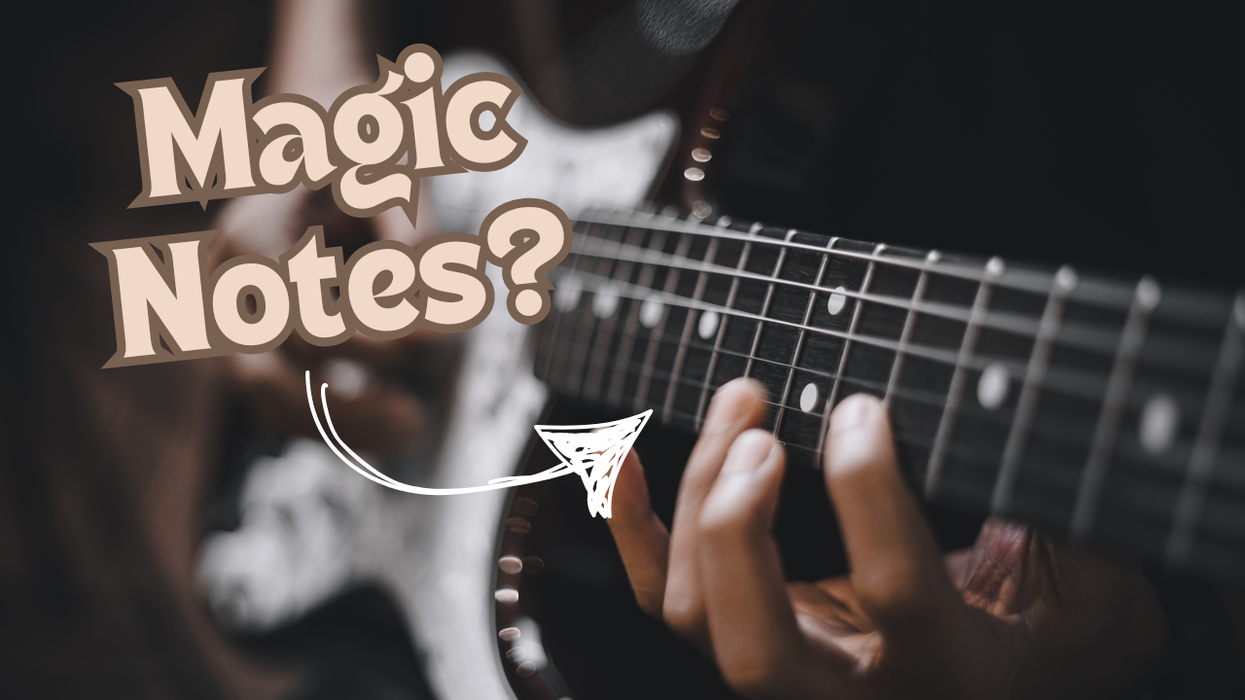This month we begin a series of lessons
that focus on developing fingerstyle
chops. Whether you’re comping jazzy harmony,
plucking snappy blues riffs, creating
harp-like runs by alternating open strings
and fretted notes, wailing on slide guitar,
frailing modal licks over drone strings,
thumping out Travis-style alternating bass,
or adding sparkle to your chordal passages
with artificial harmonics, having a strong
fingerpicking technique opens the door to
a world of sounds and textures you simply
can’t get using only a flatpick.
In the fingerstyle world, variations in hand position and wrist angle abound, and in this series we’ll look at some of the essential techniques and discuss how they work and when they’re most appropriate. And everything we cover will apply to both acoustic and electric guitar, so you’ll get maximum mileage from your efforts. Ready to roll up your sleeves and get to work? Cool, let’s go!

Many fingerstyle guitarists have created powerful and enduring music using only their picking-hand thumb, index, and middle fingers. This is especially true of steel-string players: Traditional country and folk blues, old-school ragtime, and Travis-style thumbpicking are some examples of genres that rely on a three-finger technique. If you have any doubts as to just how far you can take this approach, just listen to a hot Scruggs-style banjo player, Dobro picker, or pedal-steel guitarist. Typically, they’ll all be using a three-digit attack.
However, classical and flamenco guitarists have always used a four-finger picking technique—thumb, index, middle, and ring—and this allows them to approach the guitar as a miniature orchestra. A four-finger attack is essential to nylon-string Brazilian guitar, as well. Laurindo Almeida, Oscar Castro-Neves, Baden Powell, and Charlie Byrd are among those who merged the supple rhythms and wistful harmonies of Antonio Carlos Jobim and João Gilberto with a rigorous classical technique. (For an in-depth look at classical right-hand technique, check out “Classical Nitro,” our interview with Matt Palmer in the October 2011 issue.)
But the four-finger technique has not been the exclusive property of nylon-string players. In an effort to make the steel-string electric sound more like a piano, such fingerstyle jazz-guitar wizards as George Van Eps, Jimmy Wyble, Ted Greene, Lenny Breau, Martin Taylor, and Tuck Andress have all embraced the four-digit approach. And let‘s not forget Chet Atkins: By adding the ring finger to Merle Travis’ steamroller technique, he created an entire genre of “thumbpick” guitar that’s equal parts country, pop, and jazz.
If you want to develop orchestral fingerstyle chops—which you can apply to rock, jazz, country, and blues—it’s essential to gain control of your picking-hand ring finger, the weakling of the bunch. So we’ll begin our odyssey by playing pattern-based arpeggios that include the ring finger and require it to perform alongside its stronger siblings. Fig. 1 shows a simple bluesy figure based on an E7 arpeggio. Don’t freak out over the waves of 16th-notes—just play this passage very slowly and it will sound great.
or download example audio...

You’ll notice p–i–m–a markings in the music. These are abbreviations used by classical guitarists to indicate pickinghand fingering. The letters come from the Spanish words for thumb (pulgar), index (indice), middle (medio), and ring (anular) fingers. When practicing the exercises in this lesson, it’s important to adhere to these notated fingerings.
For variety, develop your own drills using ascending p–i–m–a arpeggios. Keep the fretting-hand part simple and listen carefully to the volume of each note. Strive for an even, ringing sound with a uniform attack on each string.
The next step is to incorporate descending arpeggios into the mix, as in Fig. 2. We also break up the rhythm just a bit, add an alternating bass, and—this is an important move—introduce a squeeze between the thumb and ring finger, which happens on the downbeat of each measure. Again, watch the p–i–m–a markings and also check out the subtle B to D move on the 2nd string in measure 3 (Em7). After several passes through this phrase, craft a few variations of your own, using a similar descending and ascending picking pattern that incorporates a p–a squeeze and an alternating p bass.
or download example audio...
So far, our well-mannered examples have used rhythmic patterns that repeat in every measure. Sometimes fingerpicking is like that—a pattern cycles again and again. But fortunately, music isn’t always that tidy. When rhythms vary, you need to have enough control over your fingers that they’ll respond to your commands. Fig. 3 is designed to break up any predictable patterns, so your fingers can’t fall back on muscle memory to execute each measure. Such “freestyle” fingerpicking takes practice, but can yield big dividends in your music. As with the previous examples, once you’ve got the hang of this, develop similar exercises of your own.
or download example audio...

Now that all four fingers are warmed up, it’s time to tackle a basic tremolo exercise. In Fig. 4, the ring, middle, and index fingers play three notes against each quarter-note thumbstroke. Here we have a descending bass line against the rippling melody, but you can also flip this passage around and ascend on the bass. Try it.
or download example audio...

Next month, we’ll look at another aspect of fingerstyle technique—developing fretting-finger independence. See you then.
 Andy Ellis is a veteran guitar journalist
and Senior Editor at PG. Based
in Nashville, Andy backs singer-songwriters
on the baritone guitar, and also
hosts The Guitar Show, a weekly on-air
and online broadcast. For the schedule,
links to the stations’ streams, archived audio
interviews with inspiring players, and more,
visit theguitarshow.com.
Andy Ellis is a veteran guitar journalist
and Senior Editor at PG. Based
in Nashville, Andy backs singer-songwriters
on the baritone guitar, and also
hosts The Guitar Show, a weekly on-air
and online broadcast. For the schedule,
links to the stations’ streams, archived audio
interviews with inspiring players, and more,
visit theguitarshow.com.
In the fingerstyle world, variations in hand position and wrist angle abound, and in this series we’ll look at some of the essential techniques and discuss how they work and when they’re most appropriate. And everything we cover will apply to both acoustic and electric guitar, so you’ll get maximum mileage from your efforts. Ready to roll up your sleeves and get to work? Cool, let’s go!
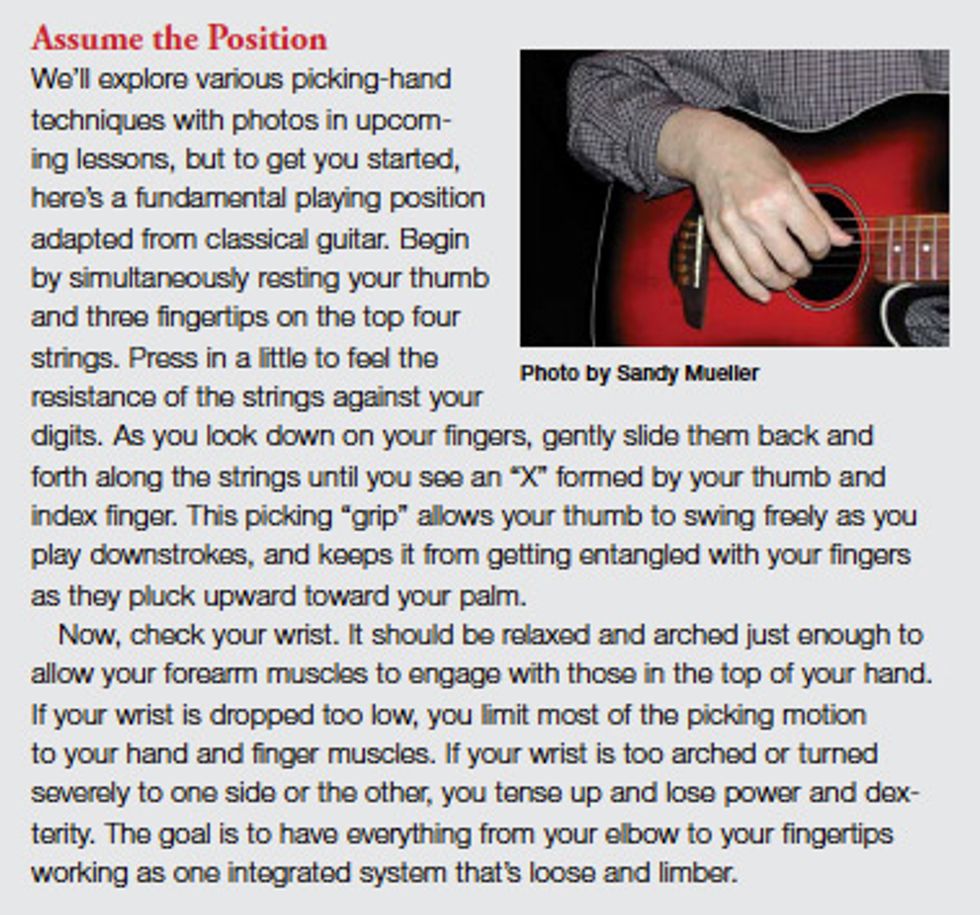
Many fingerstyle guitarists have created powerful and enduring music using only their picking-hand thumb, index, and middle fingers. This is especially true of steel-string players: Traditional country and folk blues, old-school ragtime, and Travis-style thumbpicking are some examples of genres that rely on a three-finger technique. If you have any doubts as to just how far you can take this approach, just listen to a hot Scruggs-style banjo player, Dobro picker, or pedal-steel guitarist. Typically, they’ll all be using a three-digit attack.
However, classical and flamenco guitarists have always used a four-finger picking technique—thumb, index, middle, and ring—and this allows them to approach the guitar as a miniature orchestra. A four-finger attack is essential to nylon-string Brazilian guitar, as well. Laurindo Almeida, Oscar Castro-Neves, Baden Powell, and Charlie Byrd are among those who merged the supple rhythms and wistful harmonies of Antonio Carlos Jobim and João Gilberto with a rigorous classical technique. (For an in-depth look at classical right-hand technique, check out “Classical Nitro,” our interview with Matt Palmer in the October 2011 issue.)
But the four-finger technique has not been the exclusive property of nylon-string players. In an effort to make the steel-string electric sound more like a piano, such fingerstyle jazz-guitar wizards as George Van Eps, Jimmy Wyble, Ted Greene, Lenny Breau, Martin Taylor, and Tuck Andress have all embraced the four-digit approach. And let‘s not forget Chet Atkins: By adding the ring finger to Merle Travis’ steamroller technique, he created an entire genre of “thumbpick” guitar that’s equal parts country, pop, and jazz.
If you want to develop orchestral fingerstyle chops—which you can apply to rock, jazz, country, and blues—it’s essential to gain control of your picking-hand ring finger, the weakling of the bunch. So we’ll begin our odyssey by playing pattern-based arpeggios that include the ring finger and require it to perform alongside its stronger siblings. Fig. 1 shows a simple bluesy figure based on an E7 arpeggio. Don’t freak out over the waves of 16th-notes—just play this passage very slowly and it will sound great.
or download example audio...
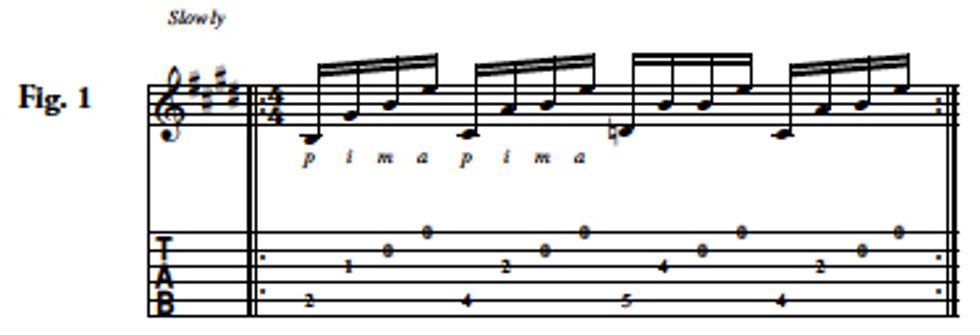
You’ll notice p–i–m–a markings in the music. These are abbreviations used by classical guitarists to indicate pickinghand fingering. The letters come from the Spanish words for thumb (pulgar), index (indice), middle (medio), and ring (anular) fingers. When practicing the exercises in this lesson, it’s important to adhere to these notated fingerings.
For variety, develop your own drills using ascending p–i–m–a arpeggios. Keep the fretting-hand part simple and listen carefully to the volume of each note. Strive for an even, ringing sound with a uniform attack on each string.
The next step is to incorporate descending arpeggios into the mix, as in Fig. 2. We also break up the rhythm just a bit, add an alternating bass, and—this is an important move—introduce a squeeze between the thumb and ring finger, which happens on the downbeat of each measure. Again, watch the p–i–m–a markings and also check out the subtle B to D move on the 2nd string in measure 3 (Em7). After several passes through this phrase, craft a few variations of your own, using a similar descending and ascending picking pattern that incorporates a p–a squeeze and an alternating p bass.
or download example audio...

So far, our well-mannered examples have used rhythmic patterns that repeat in every measure. Sometimes fingerpicking is like that—a pattern cycles again and again. But fortunately, music isn’t always that tidy. When rhythms vary, you need to have enough control over your fingers that they’ll respond to your commands. Fig. 3 is designed to break up any predictable patterns, so your fingers can’t fall back on muscle memory to execute each measure. Such “freestyle” fingerpicking takes practice, but can yield big dividends in your music. As with the previous examples, once you’ve got the hang of this, develop similar exercises of your own.
or download example audio...

Now that all four fingers are warmed up, it’s time to tackle a basic tremolo exercise. In Fig. 4, the ring, middle, and index fingers play three notes against each quarter-note thumbstroke. Here we have a descending bass line against the rippling melody, but you can also flip this passage around and ascend on the bass. Try it.
or download example audio...

Next month, we’ll look at another aspect of fingerstyle technique—developing fretting-finger independence. See you then.
 Andy Ellis is a veteran guitar journalist
and Senior Editor at PG. Based
in Nashville, Andy backs singer-songwriters
on the baritone guitar, and also
hosts The Guitar Show, a weekly on-air
and online broadcast. For the schedule,
links to the stations’ streams, archived audio
interviews with inspiring players, and more,
visit theguitarshow.com.
Andy Ellis is a veteran guitar journalist
and Senior Editor at PG. Based
in Nashville, Andy backs singer-songwriters
on the baritone guitar, and also
hosts The Guitar Show, a weekly on-air
and online broadcast. For the schedule,
links to the stations’ streams, archived audio
interviews with inspiring players, and more,
visit theguitarshow.com.




